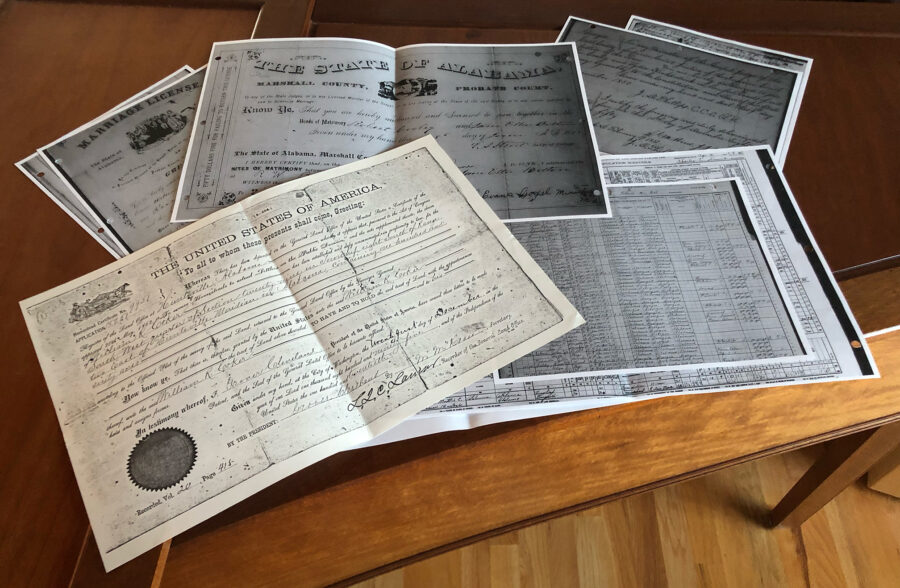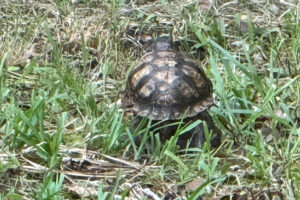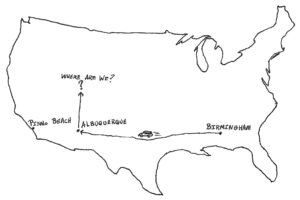The PBS show Finding Your Roots spurred my interest in learning about my heritage and where I came from. My parents never talked much about their parents, grandparents, or any other relatives—I knew only a few things about my grandparents. Both grandfathers died when I was young—I barely remember meeting either of them. Several years ago, I set out to answer the question: Where did I come from? Looking for my connection to the past seemed not only interesting but important.
Those who do not treasure up the memory of their ancestors do not deserve to be remembered by posterity.
— Edmund Burke (1729-1797) Irish statesman, economist, and philosopher
Early in my research, I read a blog that said you should give up perfection when doing genealogy. That is wonderful advice because it is easy to fall into the trap of thinking you can get all the information nailed down, written down, and documented. Perhaps you could, but it would completely take over your life—and, this has consumed my time for the last year—and longer.
The people on Finding Your Roots discovered fascinating details about their heritage and how their ancestors influenced who they became. Theirs are compelling stories filled with courageous individuals. Their accounts made me feel like my relatives must have had no ambition, must not have been interested in upward mobility, travel, or doing anything interesting. Is that true? What were their lives like and how did that influence who I am?
If you don’t know history, you don’t know anything. You are a leaf that doesn‘t know it is part of a tree.
— Michael Crichton (1942-2008) American author and filmmaker
As I explored my heritage, at times, it felt as if I would never untangle the names, the blood lines, or reach the end. I have finally gotten to a point of repose where I choose to call it good enough.
I found answers about where I came from and I discovered some interesting relatives. Several of my ancestral lines have been in America for generations . . . since almost the beginning of travel to the New World. They came from England, Ireland, Scotland, Wales, France, Germany, Norway, Netherlands, Czechoslovakia, and Denmark.

It is amazing the documents you can find online, such as census records, marriage records, and of course death records. The further back in time you go, in fact, there is more information than I could have imagined—wills, property records. legal proceedings. etc. And, much of this research has been done by others who have put the images into searchable databases.
Through the internet, I found family trees of some of my ancestors. Much information was documented, some maybe not as well. I found it interesting that several lines led back to royalty in England, Scotland, and Norway. Although I can’t vouch for the veracity of all that I found but, my gut tells me that even if some of the people I found are not really my relatives . . . I most certainly had ancestors in those same areas, with similar backgrounds. Their experiences would have been much the same if not nearly identical to the people I found.
Immersion into the history of people, places, events, customs, and cultures
Learning about my ancestors inspired me to read about events, places, and religious groups that I encountered. I also realized I have only a surface knowledge of the early history of the United States.
Many (if not most) of my ancestors came to America for religious freedom. Some came for opportunities through the Dutch West India Company. The earliest of my immigrant relatives were wealthy, owned property, and had resources to live good, prosperous lives here. However, as the years passed, that seemed to change for most of them. I believe the hardships and the effort simply to survive was difficult. And, through the years, as they traveled south from the northeast through Virginia, the Carolinas, Georgia, and finally to Alabama their lives morphed into something those earliest immigrants could never have imagined.
On two branches of my family tree there were settlers in New Netherlands and the Massachusetts Bay Colony in the 17th century. On all four branches there were immigrants who came during The Puritan Great Migration (1620-1640).
I hope to share more detailed information later, this blog is meant as a small taste with a few random sketches of some of the relatives I discovered.
Occupations and Religions
For the past two hundred years, and more, most of my ancestors were farmers. In fact, the exception is the few that were not. Some did not arrive on these shores as farmers, but those who came earliest, generation after generation of surviving must have forced them to learn to provide for themselves. It brought about a fierce independence and I would assume farming was a necessity in order to live.
My immigrant relatives were Quakers, French Huguenots, members of the Dutch Reformed Church in New Amsterdam, Scotch-Irish Protestants, and a few were members of the Anglican church. Numerous relatives donated land for churches and several attended some of the earliest churches in America.
I was particularly interested to know if any of my ancestors were musical or creative. I found a weaver, a pottery maker, a cartographer, tavern owners, surveyors, preachers, plantation owners, merchants, accused witches in Salem, and various others. And . . . yes, I found one musician and a recent relative who came from England in about 1850 who loved to sing Sea Shanties.
A Smattering of Kinsfolk (From their Flesh and Blood Came I)
Connections on my maternal grandfather’s side
Samuel Thomas Walker (1570-1622) was a Presbyterian minister at the Mongegy Chapel in Ruddington, England. He is listed as an original settler by Captain John Smith’s census at Jamestown, Virginia in 1607. He was killed at Martin’s Hundred on March 22, 1622.
Capt. Cornelius Lambertse Hendrickson (1572-1650) was a Dutch mariner and explorer. He charted the North American coastline near present-day New Jersey. He was the first white man to set foot on the soil of Pennsylvania and West Jersey.
Augustine Herman (1605-1686) was a Bohemian-born cartographer. He made extensive surveys for the boundary land lines between Maryland and Virginia. It is said that Lord Baltimore granted 4000 acres for Bohemia Manor to Augustine to do the surveys and translate them to large, engraved folio sheets. One interesting side note is that in 1683, Augustine granted 3,750 acres of land to Labadists to form a colony. Their faith was a Frisian Pietist sect that practiced a form of Christian communism that emphasized asceticism, plain dress, gender equality, and universal priesthood. The Labadists commune never managed to gain more than 100-200 settlers and ceased to exist after 1720.
Jan Gerritse Snyderken (1608-1679) settled in New Netherland about 1639. He was an early settler of Harlem and is famous as one of the three founders of the town Midwood, or Midwout, meaning “middle woods,” on western Long Island. He helped build a Reformed Dutch Church and was Deacon at the Reformed Protestant Dutch Church, Flatbush, Kings County, Long Island, New York from 1654-1656. At some point, he owned and operated a tavern and tap room—possibly the first in the New World. He was appointed Magistrate on March 30, 1654 by Governor Pieter Stuyvesant, and was one of the “Twelve Men” who were recognized by the title “Original Proprietors” in the New Netherlands.
Joseph Ashton Sr. (1654-1708) was part of William Penn’s Pennsylvania settlers community. Ashton was a member of the Church of England and gave a legacy of five pounds toward building a house of worship for this denomination at Oxford, now known as Trinity Church. Pennepack Baptist Church (also known as Pennepek Baptist Church and Lower Dublin Baptist Church) located in Bustleton, Philadelphia. It is one of the oldest Baptist congregations in North America. The church was originally Calvinist (Reformed) in theology.
Maj. Marquis Guillame Calmes II (1705-1755) was a French Huguenot nobleman. He left France and sailed to Virginia so he could worship God according to his conscience. He lived in Williamsburg a short time before moving to the Shenandoah Valley and he was one of the early settlers there. His farm is still known as the “Vineyard Plantation.” He is thought to have begun the planting of the vineyard on the plantation, which was the first vineyard planted west of the Blue Ridge. On at least one occasion, he employed George Washington to conduct a survey. Marquis Calmes II served as Major in the Virginia Colonial Militia alongside a young twenty-one-year-old Major George Washington.

Brashier’s Chapel Church and Cemetery, located in Arab, Alabama is named for Hiram Brashier (1812-1884) and his wife Irena Cox (1818-1892)—my 3rd-great-grandfather and grandmother. The Brashiers came from South Carolina and settled in Arab in 1855. Many of my relatives are buried in that cemetery, including my father and mother.
Connections on my paternal grandfather’s side
Rev. Richard Blewitt Edwards (1525-1566) was a possible (if not probable) illegitimate son of Henry VIII. He was a poet, playwright, and musician. Educated at Oxford to be a lawyer, he never practiced law but instead became a cleric in the Anglican Church. He was a poet and playwright of some renown during his time. His passing was noted by a contemporary of the time as being a writer of the same class as Shakespeare.
Rev. Sam Newman Sr. (1602-1663) graduated from Trinity College in Oxford with honors in theology. In 1635 he became disgusted with religious persecutions and came to America with a large number of emigrants including Rev. Richard Mather. Newman became a pastor of the church at Weymouth, Massachusetts. In spring of 1643-4, he and the majority of his congregation moved to a place on the east bank of the Pawtucket River called Seacunk by the native Americans. He renamed the place Rehoboth.
Newman’s famous Bible concordance was the third in English ever published. The first edition was published in London in 1643. The second edition was published in Cambridge in 1662 and was known as the Cambridge Concordance. It was reprinted as late as 1889, almost 250 years after it was first published.
Sir George Downing (1623-1684) was in the first class of Harvard in 1640. He worked his way back to England in 1645 as a ship’s chaplain. In 1649 he was appointed General Cromwell’s Scoutmaster-General which was the equivalent of a Director of Military Intelligence. In 1658 he was sent to The Hague as Cromwell’s representative to the United Provinces—which included being both a diplomat and a spymaster.
Edward Smithwick (1647-1715) was on the first vestry and present at the 1701 organization of St. Paul’s Parish, Chowan District. He gave the land for its first church building—the first church building in North Carolina. (St. Paul’s Church, Edenton, North Carolina)
Connections on my paternal grandmother’s side
Matthew Garrigus Sr. (1679-1726) and his family were French Huguenots. They left France to escape religious persecution and lived in Holland and the West Indies before emigrating to Philadelphia. He ran the Prince Eugene Tavern which offered a billiard table for sale.
“In 1726, Matthew Garrigues, at the sign of Prince Eugene, in Second Street, advertised for sale “a new billiard table,” certainly the first of which we have any account in the province.”
Bathsheba Rogers (1650-1711) was baptized and enrolled in the Newport, Rhode Island Seventh Day Baptist Church in 1676. She later became a zealous Rogerene. She was a member of the Rogers family who started the Rogerene movement, a Christian separatist religion. In aiding their cause, she suffered long and cruel imprisonments. Much of what they did paved the way for later Abolitionist developments in New England. It is interesting to note that the household she grew up in included enslaved and indentured persons.
Johannes Jurian Westfall (1659-1725) along with eighteen others bought land from the Minsi Indians along the Delaware River near the New York/New Jersey line in 1696. They were among the first white people to live in the area. Johannes Jurian Westfall planted the first apple orchard there.
Benjamin Cooley (1615-1684) immigrated to Springfield. The town was designed from the start to be an industrial, self-supporting community. Only those who could contribute something of value were admitted—such as builders, carpenters, brick masons, tailors and weavers. Benjamin was skilled with both flax and wool. In 1650 he took on an apprentice to teach linen weaving. When he died, his estate’s inventory included a sizeable amount of weaving materials, including two looms.
Connections on my maternal grandmother’s side
Gabriel Weldon (1582-1654) was licensed by Plymouth Colony to settle and own land in Mattacheese (later renamed Yarmouth) Massachusetts in September 1638. He was among the earliest settlers of this area and he was the town surveyor of highways. One of his wives, Margaret Matthews, was a sister of Rev. Marmaduke Matthews.
Sir Thomas Folland (1600-1686) migrated to New England during the Puritan Great Migration (1620-1640). In 1639 he settled in Yarmouth, Plymouth Colony. He was propounded a freeman on March 3, 1639/40. He was listed among those able to bear arms in Yarmouth, New Plymouth in 1643. Follins Pond, a brackish lake on Cape Cod which separates the towns of Dennis and Yarmouth, Massachusetts was named for Thomas Folland. The lake is connected to Nantucket Sound via the Bass River. Follins Pond is noteworthy primarily because there has been an attempt to connect it to the semi-legendary lost Norse colony of Vinland.
Jacob A. Weldon II (1723-1783) and his family were the first Weldon family in Georgia. He was given grants in St. Paul Parish—later Richmond Co., Georgia in 1773. What he actually got seems to be land that he had already been living on and had converted from wilderness into farmland. He and/or his wife were associated with a synagogue there and may have been of Jewish Heritage.
We inherit from our ancestors gifts so often taken for granted. Each of us contains within this inheritance of soul. We are links between the ages, containing past and present expectations, sacred memories and future promise.
— Edward Sellner, professor of pastoral theology and spirituality

Final Thoughts
This research has given me a great appreciation for my family and a better understanding of where I came from. I am amazed at the strength and tenacity generation after generation showed—even if by merely existing in such hard, often unforgiving, circumstances.
They valued their religious beliefs. They were adventurous and weren’t afraid to travel across the ocean to a new place. Once in America they worked hard. As generations went by, some made it to Alabama during the 1800s.
Much to my surprise, my story does not begin with my parents—it stretches back hundreds of years to many other people deeply rooted in the fabric of this country. And, my roots extend back to ancestors before them who traveled from distant countries in hope of freedom of religion and a better life for their families.
This challenges me to make the most of what I have so that their sacrifices and hard work are not in vain. They had vision and purpose—so must I.
To forget one’s ancestors is to be a brook without a source, a tree without a root.
— Chinese Proverb










Leave a Reply
Your email is safe with us.